 | E-mail to Birds Korea |
 | KWBS |
in the Region
 | The Oriental Bird Club |
 | BirdLife International (Asia) |
December
Periods of intense cold alternate with milder spells. In the coldest winters maxima are often below freezing; in milder years (such as 2001 and 2002) maxima often reach 10°C in Seoul: a few lingering autumn migrants can still sometimes be found as well as huge numbers of wintering waterbirds.
A great time for full winter bird tours or a couple of days in the right areas. Saunders's Gulls are widespread, while Relict Gulls also start to appear at a number of sites, especially in cold winters. Scaly-sided Merganser move southward onto unfrozen rivers, while numbers of Baikal Teal remain at their peak - often dispersing southward from Seosan, along with large numbers of Greater White-fronted and Thick-billed Bean Geese with the onset of subzero temperatures. Taiga Beans too can be found in the low thousands at Woopo, Joonam and in the Nakdong in the southeast, the mildest part of the mainland.
Raptors include good numbers of Cinereous Vulture (especially in recent years) and these are often joined by White-tailed and several Steller's Sea Eagles, while cranes (Red-crowned, Hooded, and White-naped), remain at key sites.
Passerines include occasionally abundant Brambling, mixed flocks of Naumann's and Dusky Thrushes and in some winters large numbers of Siberian Accentor. Species such as White's and Pale Thrush, Red-flanked Bluetail and Japanese White-eye also remain in reasonable numbers on Jeju Island and in the far southeast. Highlights in December 2002 included Korea's first Great Black-headed(or Pallas's) Gull in Seoul, Pigeon and Spectacled Guillemots off the east coast, and several Red-throated Thrushes and Chinese Nuthatches in the northwest. Highlights in 2003 included Korea's first Grass Owl - found dead on Heuksan Island.
(The following records are a compilation of our own sightings and records sent in by other observers. As well as being posted on the Birds Korea website(s), selected records are also forwarded to other Korean-language birding websites; records of threatened species are arranged and forwarded to Birdlife International and national authorities when appropriate; flag images and records are passed to bodies responsible for their coordination throughout the flyway; and all records sent to us are used to compile annual reports and to support the evolving understanding of the status of many of Korea’s birds.)
Nakdong Estuary, December 30
In two hours at Miyeonji, great views of an Eastern Lesser Whitethroat (South Korea's third record, first found on 29th in subzero conditions by Phil Hansbro and Dave Sargeant), as well as an Eastern Marsh Harrier and a neck collared Whooper Swan (red, with white lettering: 2K22).
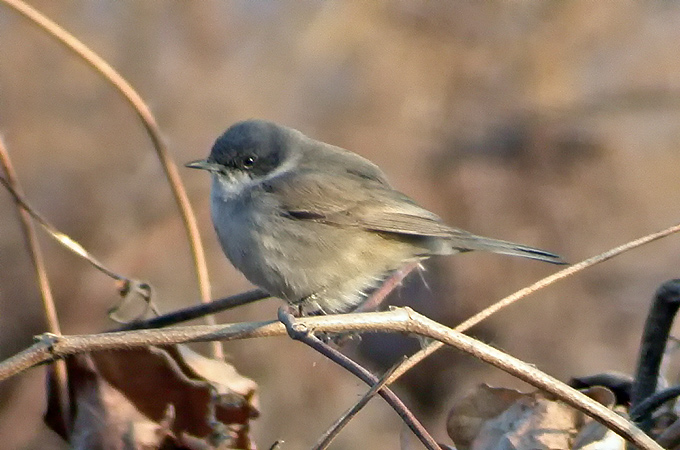
Nakdong Estuary, December 28
In much colder conditions, with a strong northwesterly wind, a long and unsuccessful search for Relict Gull, including two hours in a wave-washed dinghy...
Highlights for the day included 2 stunning Steller's Sea-Eagles (one full adult and one 4th year), 6 White-tailed Eagle, an Eastern Marsh Harrier, 2 Harlequin Duck, a Little Tern (this is an exceptional date) and a medium-large, heavy-billed pale-mantled first winter gull tentatively identified as a probable Ring-billed Gull (although distant images were taken, they sadly seem unlikely to confirm identification one way or another).
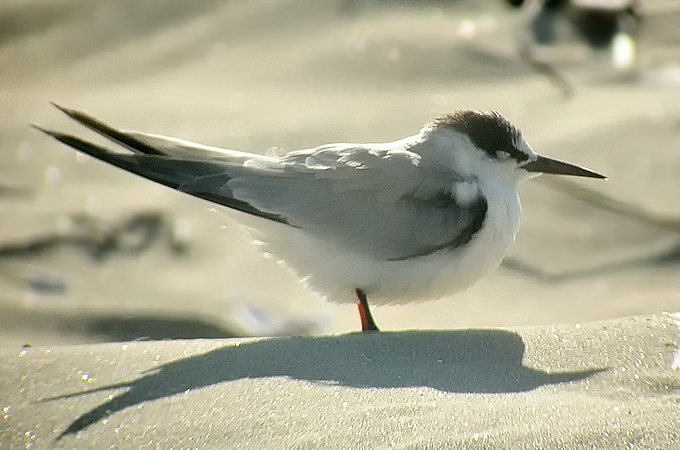
On 29th, DS and PH also found one adult Relict Gull in the same area: perhaps the first record of this species this winter.
SE River and Joonam Reservoir, December 27
In still mild conditions, an excellent morning's birding along the SE River.
Minor highlights included 2 Brown Dipper, many Japanese Wagtail, 4 Mandarin Duck and several Meadow Bunting, medium highlights included 2 Northern Goshawk and ca 40 Cinereous Vulture feeding close to the road, and outstanding highlight 5 Scaly-sided Merganser (2 pairs and one additional female).
If this was not enough, the same stretch of river (and in fact, as the photos show, the same rock) also held a male and a female Plumbeous Water Redstart, apparently paired and perhaps in territory! This is only the third record of the species in Korea (with all records coming this year, the first in January), and the first record of two together.
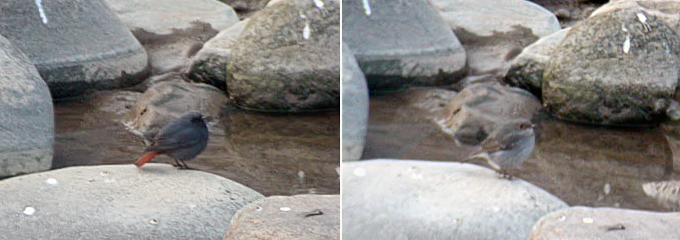
In the afternoon, Joonam also provided some very good birding, with 56 White-naped Crane, an adult Lesser White-fronted Goose and a small and rather dark Cackling Goose, along with 100+ Smew and probably 75 Falcated Duck, the species most of note.
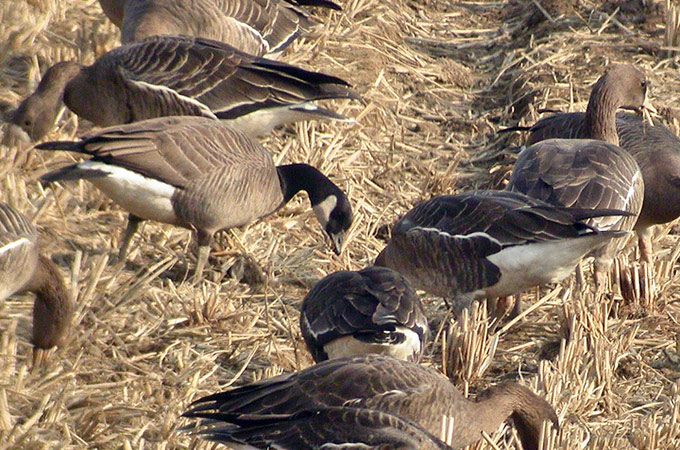
Gunsan vicinity, Geum River and Napo vicinity, December 25
Kae-jang Village had a mix of Buntings including Black-faced spodocephala. Oh-seong Mountain gave a good topside view of a Common Buzzard as it flew below us. The west slope was fairly quiet, but sounds of one or more Pale Thrushes could be heard.
At the Geum, Common Reed Buntings were among the reeds as an excavator worked at destroying them.
At the Seong-san Reservoir near Napo many Falcated Teals and three Gadwalls were seen. Also in that vicinity, a Eurasian Sparrowhawk was seen during a flyby.
On the tidal flats of the Geum a singleSpotted Redshank was seen. Its presence could be explained by the fact that it was missing most of its flight feathers on the right wing. A group of perhaps 30 Northern Lapwings were seen flying over. Several attempts to get an accurate count of Swan Geese produced a mode of 41 including two with numbered neck-collars: R90 and R05.
Heuksan Island, December 21
Another first record for Korea (and perhaps only a second record for Far East Asia, after one in 1997 in Fukuoka, Japan) a Meadow Pipit Anthus pratensis was photographed on 21 December, on Heuksan island by Park Jong-Gil of the National Parks Migratory Bird Centre.
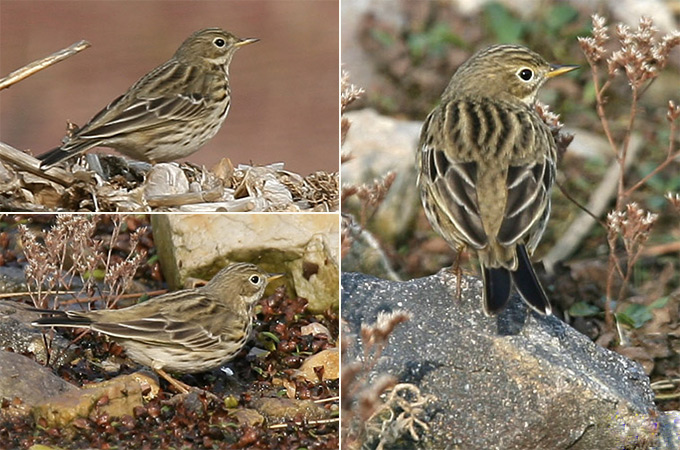
Han/Jungnang river, Seoul, December 16
The full gamut of wintering ducks ranged from Oksu to Eunbong today, although the numbers have yet to build up to match last year.
A raft of 190 Goosander at the confluence of the two waterways is the largest single pack I have seen of these so far. Nearby, 6 Smew, c. 800 Tufted Duck, 200 Common Pochard and a lone Greater Scaup. Further up the quieter Jungnang stream, 200 Northern Shoveler, 400 Northern Pintail, 100 Mallard, 100 Common Teal, 100 Spot-billed Duck, and 30-40 Gadwall cropped the grassy bank, in their regular spot. 3 Eurasian Wigeon & 1 Mandarin were firsts for this area.
Sadly, a newly constructed bridge imposes over a formerly waterfowl-favored stretch, likewise new tennis courts have replaced the woods that were on the bank.
Gimpo, December 10
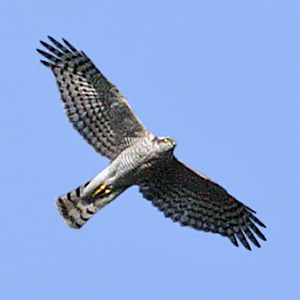
Photo © Tim Edelsten
The first freeze this winter, and a mixture of Bean but predominantly Greater White-fronted Geese flew between the coastal rice paddies. On mudflat nearby, a family of 5 Swan Geese burrowed deep, while "dad" kept alert watch.
The deciduous hills of Munsusan were patrolled by several Common Buzzards, a female European Sparrowhawk, and a duo of soaring White-tailed Eagles which once again performed an aerial ballet. They were quite unfazed by the pack of Large-billed Crows mobbing them: other corvidae included several Rooks lined up on wires at Tongjin, and a noisy group of 13 Azure-winged Magpies in the orchard. Also 2 Bull-headed Shrike, 2 Greater-spotted Woodpeckers, and an assortment of Daurian Redstarts, Rustic and Yellow-throated Buntings. Reedy ditches sported at least 10 Meadow Buntings loosely associating with many Vinous-throated Parrotbills.
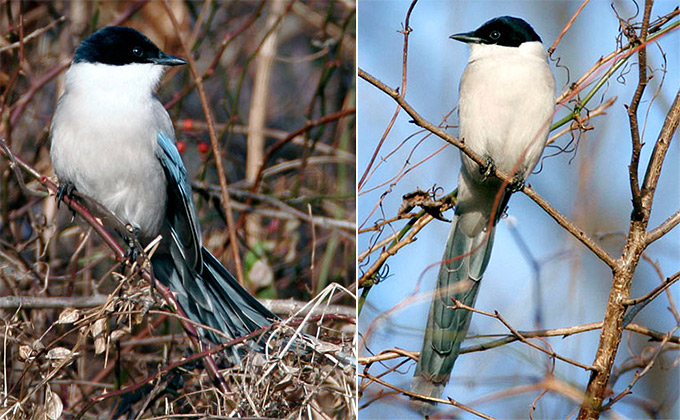
Seosan Lake A, December 10
A great day at Seosan started with great views of a Korean Water Deer. Shortly after that, at the first blind, we saw 2 Oriental White Storks, lounging about in ankle-deep waters. With the sun behind and calm waters in front, we had some excellent views. Also there were 8 Ruddy Shelduck, a few Common Shelduck, Cormorant species and 3 Pallas' Reed Buntings along the edge of the lake.
Further along brought droves of Black-necked and Great Crested Grebes, the final count standing at c.150 of the former and c.200 of the latter. Little Grebes grew more numerous as the day progressed, but were out-numbered greatly. Buff-bellied Pipit, White Wagtail lugens and a flock of c.100 suspected Lapland Longspur brought us to the far end of the lake.
Once there we counted 48 Eurasian Spoonbill and 236 Whooper Swans along with 4 seemingly out of place Long-billed Crows. Also there were Common Merganser, Goldeneye and Common Teal. The river further north yielded a Common Buzzard, 2 Green Sandpiper, Eurasian Sparrowhawk and Eurasian Wigeon. Kestrels were numerous as were Bean Goose and Greater White-fronted Goose, though no rarities found in our scanning.
On the way out we birded from the snack store at the far end of the bridge, then carried on around the West side of Lake A, spotting a Saunder's Gull, several Red-breasted Merganser, Tufted Duck, Smew and Pochard. A great day with 51 species logged, including lifers for both birders.
Namyangju and Gwangneung Arboretum, December 10
A day exploring new areas between Guri and the Arboretum yielded some good birds. A small group of around 9 Longbilled Plovers along with good numbers of Japanese Wagtail and Green Sandpiper showed that in the right habitat these species can be quite easy to find.
Around 20 Mandarin Ducks along with various other species including two Common Merganser. Overhead were many Cinereous Vultures and a lone Daurian Jackdaw. In scrub along the river's edge a single Siberian Accentor, various Bunting species and 4 Bullheaded Shrike. Close to the Arboretum there were two Brown Dippers, a scattering of Hawfinch and 2 Grey-headed Woodpeckers to bring the days total to 41 species (not including the family of feral Guineafowl).
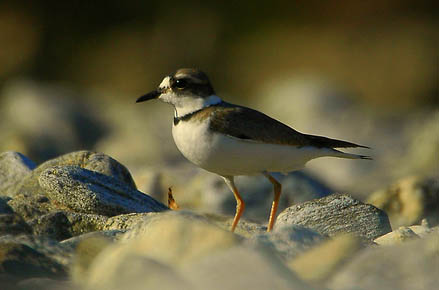
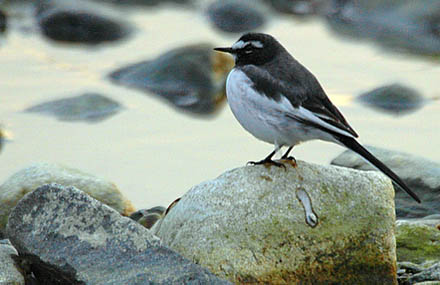
Seosan, December 3
Bright,clear and cold (around -6 degrees) at lake A today. Highlight were adult and immature White-tailed Sea Eagles, which performed spectacularly, meeting and joing talons in mid air.
Oddly unseasonal birds included a Common Kingfisher, lone Zitting Cisticola (listed in 'Lee, Koo and Park' as a scarce resident), and 2 Black-faced Buntings.
At least 200 Lapland Buntings swirled and massed in flocks over the rice fields, complimented by several Eurasian Skylarks and 2 Buff-bellied Pipits.
Up to 19 Hooded Cranes, (including 4 or 5 juveniles), flew most gracefully, accompanying the many Bean and Greater White-fronted Geese: also of note were 4 Northern Lapwings, 2 European Spoonbills, and Pallas's Reed Buntings.
On the water, Black-necked Grebes were much in evidence, also several Little & Great Crested: c.25 Goldeneyes, 1 Common and c70 Ruddy Shelduck, Coots, Goosanders, and the usual mixed bag of Shoveler, Teal, Mallard, Spot-bill, Pintail & 1 Tufted Duck. Alba Great Egrets were scattered around the paddies, while a Bull-headed Shrike and a Kestrel posed for the camera nicely.
Excellent prolonged views were had of a hunting Amur leopard cat, and a Chinese water deer.
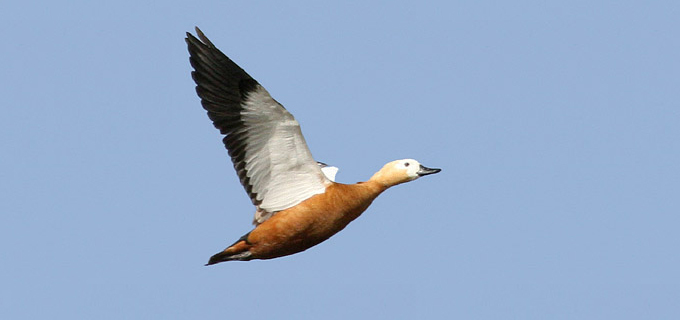
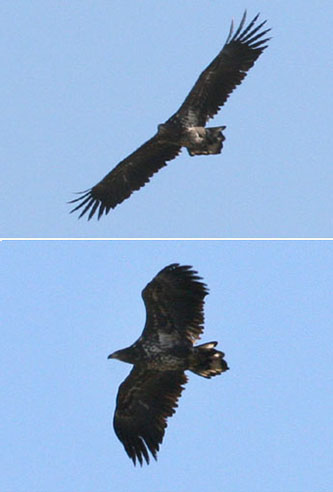
Photos © Tim Edelsten
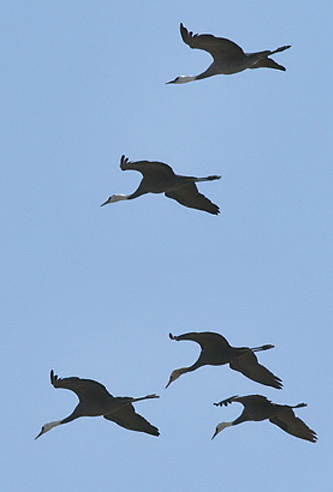
A Great Knot Calidris tenuirostris was sighted by Arthur and Sheryl Keates at: between Lee Point and Buffalo Ck, Darwin, NT, Australia 12deg 19min 46sec S, 130deg 53min 46sec E on 3/12/2006 with flag(s) as follows:
LEFT leg: white flag on tibia (upper leg) above orange flag on tarsus
RIGHT leg: nothing/unknown on tibia (upper leg) above nothing/unknown on tarsus
This bird was flagged in Korean Peninsula, approximate co-ordinates 36deg min N, 126deg 40min E, which uses the flag combination White/Orange, sometime since 1998.
The resighting was a distance of approximately 5393 km, with a bearing of 174 degrees, from the marking location.
Seen among the c3900 Great Knot and c200 Red Knot present at the time.
A Great Knot Calidris tenuirostris was sighted by Arthur and Sheryl Keates at: between Lee Point and Buffalo Ck, Darwin, NT, Australia 12deg 19min 46sec S, 130deg 53min 46sec E on 19/11/2006 with flag(s) as follows:
LEFT leg: white flag on tibia (upper leg) above orange flag on tarsus
RIGHT leg: nothing/unknown on tibia (upper leg) above nothing/unknown on tarsus
This bird was flagged in Korean Peninsula, approximate co-ordinates 36deg min N, 126deg 40min E, which uses the flag combination White/Orange, sometime since 1998.
The resighting was a distance of approximately 5393 km, with a bearing of 174 degrees, from the marking location.
This bird was one of a total of 5 flagged Great Knot (with different flag combinations) which were seen among c. 4100 Great Knot and c. 200 Red Knot.
A Terek Sandpiper Tringa cinereus was sighted by Andrej Y. Blokhin & Ivan M. Tiunov at: Chaivo Bay, Sakhalin I., Russian Federation 52deg 29min 40sec N, 143deg 17min 39sec E on 28/05/2006 with flag(s) as follows:
LEFT leg: white flag on tibia (upper leg) above orange flag on tarsus
RIGHT leg: nothing/unknown on tibia (upper leg) above metal band on tarsus
This bird was flagged in Korean Peninsula, approximate co-ordinates 36deg min N, 126deg 40min E, which uses the flag combination White/Orange, sometime since 1998.
The resighting was a distance of approximately 2251 km, with a bearing of 30 degrees, from the marking location.
Corresponder: Pavel Tomkovich, Observer: Andrej Y. Blokhin & Ivan M. Tiunov
Gunsan: Oh-seong Mountain, Keum river and Na-po area, December 3
GS reported a group of Rooks on his way over to meet us.
A drive over Oh-seong Mountain was productive and a couple of feeding flocks of Tits were encountered. On the west slope a single Red-flanked Bluetail and a few Japanese White-eyes were seen.
At the Geum about 60 Eurasian Curlews were counted. A small group of Common Gulls and a few Saunders' Gulls were seen there as well. PN noted the presence of Swan Geese. As the tide was nearly covering the mud, a swift Eurasian Sparrowhawk male flew low over the mud not far in front of us.
About 600 Greater White-fronted Geese were counted in the rice fields near Napo Village. Baikal Teals are in the 100's of thousands. In the Seong-san Reservoir a few Falcated Teals and a loud active feeding group of 17 Whooper Swans were watched and listened to well. The Long-billed Plover noted last week is still there. It was seen today resting on the east shore.
Yanggu, December 2
In Yanggu on Saturday Dec02 around08:50 I saw 5 Cinereous Vultures heading in a southly direction along the valley on the west side of Yanggu Eup. I suspect they are hungry and dispersing to more places to find food. I only saw one Cinereous Vulture before in early spring 2006 in Yanggu Eup. Last winter there was a Vulture feeding site near Bangsan in the northwest of Yanggu County near the DMZ.
Mangyeung River, Geum Estuary (northern coastline), Seosan A, December 2
Despite the weather, 79 species logged. In subzero temperatures with occasionally heavy snow showers, the day again started well, with probably 200000 Baikal Teal watched flying over the road towards their roost on the Geum. The very elusive Oriental White Stork was again at the Mangyeung (though very distant), along with ca 30 Saunders's Gull and 4, 400 Dunlin. At the Geum Estuary, along the Socheon coast, a further 215 Saunders's Gull, 5 very late Far Eastern Curlew mixed in with 620 Eurasian Curlew, and most unexpected of all a (first-winter) female American Wigeon. Though the axillaries were not seen, the combination of head shape; grey head and dull body tones; head pattern, with dark patch and contrasting pale forehead and lores; and the bill pattern, with dark ring around the base of the bill, all supported the identification.
Further north, at Seosan A, more persistent snow and strengthening winds made birding a little difficult, with the highlights including another Oriental White Stork (on Lake A), a total of ca 620 Lapland Bunting, and stunning views of a Chinese Grey Shrike at Lake B.
December 1, Seosan A and Geum Estuary (including northern tidal-flats)
An excellent day, with ca 76 species logged in total. In fair but breezy weather conditions, with temperatures struggling to 6C in Seosan but 12 C in Gunsan, several great birds. At Seosan A, the day started well with good views of an Amur Leopard Cat, and 2 Common Crane roosting in with Hooded Crane (55 logged in total), with the latter at one stage sharing the same field with an adult Snow Goose. In addition, great views of Pallas's Reed Bunting and poorer looks at an Ochre-rumped Bunting (all flushed by an EBS TV documentary team). In addition, an Upland Buzzard showed briefly there, while perhaps most unusual was a Bean Goose with a completely orange bill (apart from a dark nail), well-scoped but sadly not photographed.
At the Geum Estuary, 37 Swan Goose (2 with neck collars still), an adult Lesser White-fronted Goose watched well at Napo Ri, and most exceptional, 2 extremely late Chinese Egret at the coast. The evening became calm and clear, and counting of the Baikal Teal flock on the water and in the air suggested that an incredible 600000 birds were present - performing aerial ballet for 10 minutes at dusk, before flying right over us and on south towards the Mangyeung.
Birds Korea 1108 Ho, 3 Dong, Samick Tower Apt., 148-22, Namcheon-Dong, Su-Young-Gu
Busan, 618-762 Republic of Korea





